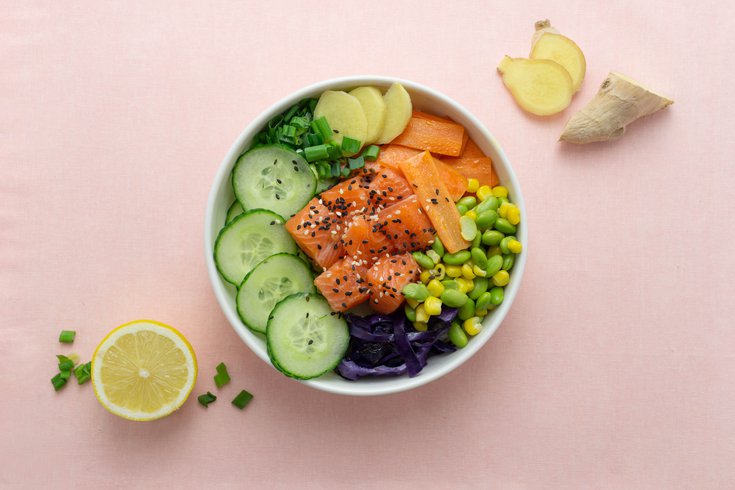
December 20, 2022
 Mia Sua/Unsplash
Mia Sua/Unsplash
The Flexitarian diet is mostly vegetarian, but allows for the occasional consumption of meat and animal products, including anything made with lard or gelatin, which comes from animal bones and hooves.
The Flexitarian diet – a mostly vegetarian approach that allows for the occasional consumption of meat and animal products, including lard and gelatin – has been touted for helping people reduce their consumption of processed foods while not requiring them to go cold turkey.
Eating too much meat, particularly red meat and processed meats that are high in fat, is known to increase the long-term risk of heart disease, diabetes and certain types of cancer.
The Flexitarian diet doesn't carry strict regulations or require calorie counting like others. Instead, it simply emphasizes healthy recipes.
The Flexitarian diet has been lauded as one of the best overall diets by U.S. News 7 World Report, which also has praised being among the best for weight loss and for people with diabetes.
The bottom line is that a Flexitarian approach focuses on eating fruits, vegetables, whole grains, legumes and nuts, but occasionally permits the consumption of meat. Still, that meat is recommended to be organic, free-range, pasture-raised or grass-fed beef, chicken or turkey. Leaner cuts are advised to minimize extra animal fat. Fish are a good source of protein, but people are encouraged to choose wild-caught varieties. Yet, the majority of proteins should come from plants.
If your New Year's resolutions include cutting back on red and processed meats, here is what you need to know about adopting this diet.
Studies have shown that following a Flexitarian diet can decrease the risk of heart disease and type 2 diabetes and aid in weight loss. It is also better for the environment because meat consumption is linked to carbon footprints. Some research also suggests it may also help prevent cancer.
Though more research focuses on the benefits of a fully vegetarian diet, one 2020 study that investigated the vegetarian, pescatarian and Flexitarian diets found that people who adhered to any diet that excluded or reduced meat intake had lower body mass index, total cholesterol levels and blood pressure levels than those who ate meat.
Another study, with more than 200,000 participants, found that a diet that emphasized plant foods and was low in animal foods could reduce the risk of diabetes by 20%.
Not much is known on the association between a Flexitarian diet and cancer, but one study found that semi-vegetarians were 8% less likely than non-vegetarians to be diagnosed with colorectal cancer.
Some research also suggests that a semi-vegetarian or Flexitarian diet may help treat inflammatory bowel diseases, such as Crohn’s disease.
Though a Flexitarian is an overall healthy eating pattern, it can increase the risk of nutrient deficiencies, like vitamin B12, zinc and calcium. It's possible to get enough of these nutrients solely from plant foods, but Flexitarians need to plan their diets carefully to accomplish this, nutrition experts say.
People who suffer from irritable bowel syndrome, might have digestive issues from the heavy-plant-based diet. Another concern is that not all plant-based meat substitutes are healthy. According to a 2019 study, some meat substitutes don't provide key nutrients.
The Flexitarian diet allows people to choose how much meat they want to cut out of their diets. The general rule of thumb, however, is anywhere from 9 to 28 ounces of meat a week.
The diet plan recommends people reduce their meat consumption in three stages. In Stage 1, people are advised to avoid eating meat two days each week. And they should limit their meat consumption on the other five days combined to 28 ounces.
In Stage 2, people focus on following a full vegetarian diet for three or four days each week. During this phase, people are advised to limit themselves to 18 ounces of meat during the rest of the week.
By Stage 3, people should be able to follow a full vegetarian diet for five days each week. They should limit their meat consumption to 9 ounces combined on the other two days.
For this eating approach, stock the kitchen with fruits, vegetables, beans, brown rice, oats, barley, quinoa, plant-based milk, eggs, some dairy, nuts, seeds, health fats, oils, herbs and spices. Limit consumption of meat, poultry, fish and anything with added sugar or refined carbohydrates.
Here are some sample meal combos from Healthline, Western Oregon University and EatingWell.com that can help people get started.
For breakfast:
• Steel-cut oats with apples, milled flaxseed and cinnamon
• Muffin-tin omelets with bell peppers, black beans and Jack cheese
• Strawberry-pineapple smoothie
For lunch:
• Whole grain wrap with hummus, vegetables and chickpeas
• Quinoa salad with tomatoes, bell peppers, black beans and corn
• A veggie and hummus sandwich
For dinner:
• Stuffed bell peppers with ground turkey and a side salad
• Tacos with grilled fish, bell peppers and onions
• Greek salad with edamame